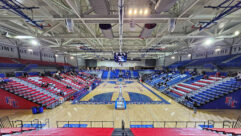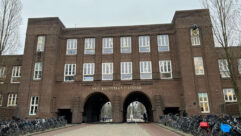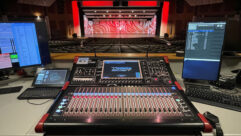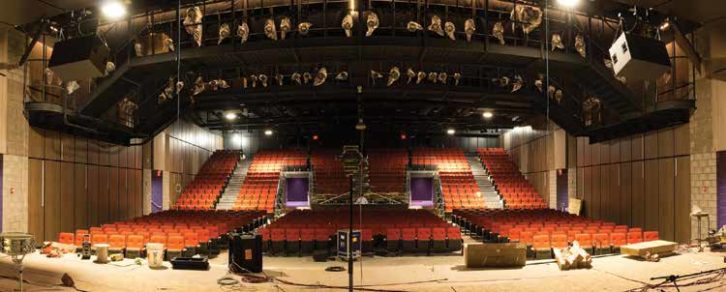
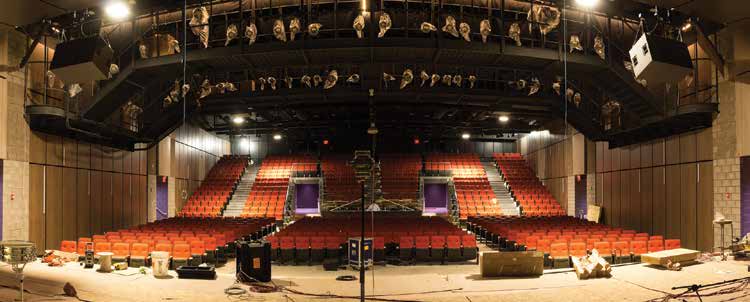
Physical acoustic treatment, hanging curtains, installing reflective clouds and carpet used to be the only way to change the acoustics of a performing space. The Baldwinsville High School auditorium needed an adjustable acoustic environment to accommodate a wide variety of weekly events and an ambitious music curriculum. Seth Waltz and AVL Designs came in with Yamaha’s Active Field Control (AFC) and he’s here to tell us about how it works.
SVC: Is this sort of project typical for AVL Designs?
Seth Waltz: We’ve been using AFC for probably about eight years. We’ve got 22 systems currently that we’ve designed that are installed and operating. We’ve got a bunch of other ones in design. It’s been continually improving; the software and algorithms just keep getting better. AFC lets us give a space variable acoustics over the whole frequency range, which you can’t get with curtains and other methods that people have used over the years to try to vary the acoustics. This school typically does 53 concerts and events a year. They’re either music productions, plays – all sorts of high-end stuff – and it’s a very aggressive music program. They really wanted to have the right acoustics for every style of music.
Overall, what did they want to accomplish with the renovation of this auditorium?
They wanted a true performing arts center, but we were stuck with a footprint and roof height in an existing part of the building that could not increase. So we had to look at some innovative ways to get lighting, catwalks and everything else we needed in the room. Because of the sightlines we ended up with bleacher seating, which acoustically creates some real problems for music. You end up with not enough air in the room. The maximum reverb time we get out of the space physically was limited. They do orchestra and they do operatic things in there, so one of the biggest challenges was to do something about the room acoustics within the physical shell. We chose a black box design; no ceilings. The roof deck of the room is the ceiling. There are some tuned absorbers and things hiding up in that black cavity that you can’t really see. Some of the wall panels are acoustical. Some of them are hard. So there are things used to tweak the room itself. But the AFC was planned in to let us move that reverb time around and change the characteristics of the room at will.
How did that system help this venue to get where they wanted it to be?
We actually did get to design the entire interior of the room. We picked the seats, the acoustic character of the seats, the walls. We were stuck within the existing envelope, but everything was gutted. The key thing was tuning the room so that it had a particular basic response, so when the AFC takes over it can do the things it can do. There are limits to how far you can extend certain frequencies. Mechanical noise has to be extremely low, so we worked with a mechanical engineer to get that under control. There are things you have to do to set the AFC up to work. But then, literally, you can sit in the room and close your eyes and as you run through presets you can hear the room get larger. You can hear bass extension that wasn’t there before. You can hear surround sound type effects where sidewalls are bringing more energy, which simulates a much more expensive room with a lot of fancy stuff we really didn’t have in the space. So it’s way beyond a surround system. It has so many capabilities, and we’ve got it wired so they can use it for sound effects out of individual speakers within the room.
Can you describe Active Field Control?
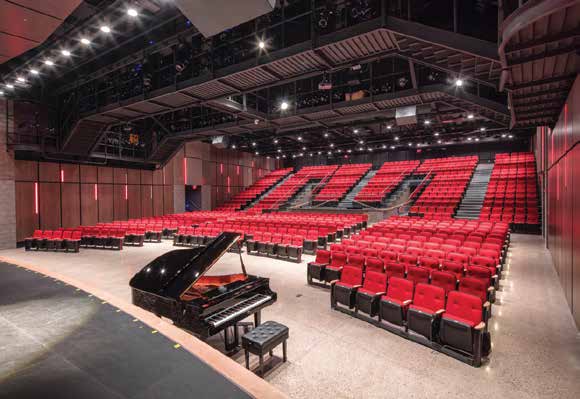
The algorithm is basically data from a group of microphones that are placed over the stage and another group that are placed out in the house in front of the stage that pick up all the energy, and then a particular distance that is worked out in design based on the reverb time of the room. Then that’s run through software that simulates all these impulse responses that aren’t really in the room and it’s played back to the room through the speakers. It’s not like a reverb unit like you use in the studio, but it has that sound quality. But because each of the dozens and dozens of speakers placed all throughout the room are individually processed you can literally move the walls away or the ceiling away and steer the way the room behaves for the particular type of performance you’re doing.
I can imagine that’s a very special experience being able to just close your eyes and hear the whole building apparently changing shape and changing size.
The first time we heard this, Yamaha had it in their piano studio in New York City, which has about a 12-foot drop ceiling. They had a string quartet in there and a grand piano, and I literally had to close my eyes because I knew I wasn’t hearing the room I was sitting in. It was so good that it really made you feel like you were in about a 400-500 seat room—not in a room with a drop ceiling that seats about 50. And that was the really early version, which had some edge to the sound. It’s like if you slapped your hand on something you’d hear some reverb tail that wasn’t natural, but that’s all gone now. This thing has come so far that it’s fooling professional classical musicians in a number of venues we’ve used it in.
So how many different settings do you have on this one? How would you set it up differently for say, a presenter at a school assembly or for a musical group?
We’ve got one setting that’s called Voice Lift, which just does additional early reflections. It raises the natural sound of a person on stage by almost as much as six decibels in the seating area—without using the sound system that’s in the room. In a lot of the venues we’ve done, a person can give a lecture on stage—if they have a decent voice—without using a microphone. Then when we go to a music mode, we will increase the reverb time of the room. We’ll change the base extension of the room and base ratio, depending on the style of music. In the stage rigging there is an electronic shell for the stage so that they don’t have to have those big, physical wood shelves to bounce sound back to the musicians. There are half a dozen presets for the seating area and a half a dozen presets for the stage. They’re controlled through a Crestron system where you select the style of music and you select if the stage is active or not, so you have some options depending on what you’re doing. It’s literally going from sounding like a lecture hall to sounding like a concert hall over a variety of settings for different styles of music.
And of course, playing around with it and going through all the settings after it’s installed is the fun part.
Exactly.
What was involved in connecting all of the wiring and components for this system?
I think we’ve got something in the neighborhood of 84 loudspeakers in the room. I don’t remember off the top of my head, but it’s a large number. Every single one is a home run. No parallels. Every unit is driven by its own processing, its own amplifier, so it’s just a mile of wire. And they all have to be at particular heights relative to the seats going up to the seating area because it’s shallower. We had to use more loudspeakers in the back to get the coverage so you don’t have any hotspots. It’s a lot of rigging, a lot of writing, and kind of a configuration they’re not used to because it’s like a distributed sound system.
This place would have some kind of stage monitoring. Are the acoustics onstage separately adjustable from those in the house?
Yep. The AFC system can be on early reflection so that the actors on stage hear themselves better in a play, for example. Even though they may be wearing head mics that are going through the PA, this lets them hear themselves without floor wedges or side fill monitors on stage— they’re all there too, but that’s a whole other system. You can completely adjust the two separately. So depending on how the operator wants to run an event they can do some pretty special things without having to do traditional sound reinforcement techniques for everything.
How many of the AFC systems did you say you’ve installed so far?
We’ve got 22 that are installed and we’ve got probably another dozen that are out—either bid or in design right now. So we’ve had quite a history with them. Our oldest one is eight years old and we do keep track of them. We’ve never had a failure. But the other thing is—I can’t name names—but we’ve had professional artists in a lot of these rooms and we’ve heard back from their sound engineers that they loved the acoustics of the room and they had no idea the system was in there. And these were kind of plain Jane looking rooms.
If you’re in one of these rooms and you turn the AFC off, the room doesn’t sound bad because we’ve tuned it to be neutral and not have any weird aberrations like echoes or anything strange. But when it shuts down, it’s disappointing. It’s like you just lose this musicality that is there. We could design a room physically—and we’ve done it. But when a room is that live and it has that much bass, you can’t put a rock-and-roll band on stage, or a brass ensemble, because the room is going to be too much. The beauty with this is you can have this orchestra play with all the subtly and nuance and then when you’re doing the talent show with a rock-and-roll band you turn it to one of the really low presets where it’s barely doing anything.
When you start this kind of project, what sort of acoustic slate do you need to have as far as the walls, floor and ceiling? Do you have to do any physical acoustic treatment first?
If you want it to work optimally you have to make sure the room does certain things and doesn’t have any real aberrations. So we do acoustic modeling because we do a lot of physical acoustic design. So for example, if they have single-layer drywall throughout a room, the room will be bass-deficient because the bass is absorbed by the drywall cavity. So we put in masonry or double drywall or something to bring the low frequencies up. That’s because the system can only go a certain percentage above the natural conditions of the room. We come up with target reverb curves that we want for orchestra, choral, different styles. And then we have to make sure the bass condition of the room meets the requirements for the system to be able to do what it needs to do. And then you’ve got to make sure there are no slap-back echoes, no flutter echoes, other things that would then basically get back into the microphones again and create problems. AFC can’t take things out of the room—it can only put things into the room. If you want it to be ideal, you really have to design the room as part of the package. When we talk with an end user we explain that to them—if AFC is going to be in the job we design a room differently. If they weren’t going to do this, we’d go with some middle-of-the-road reverb time that would be completely different than what we do for AFC.
What sort of speakers do you like to use on the Yamaha AFC for best results with that?
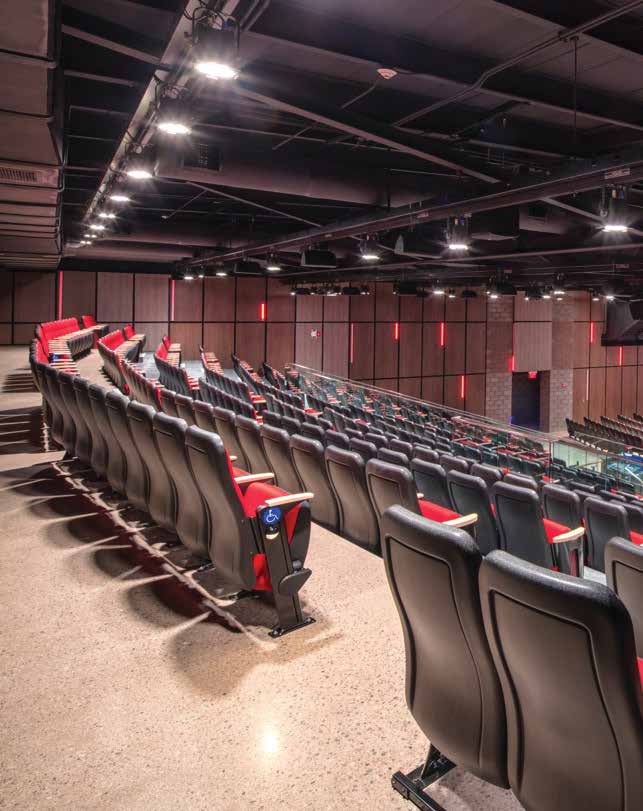
There’s a set of parameters that Yamaha has for loudspeakers and we used all Yamaha product on this particular job. They make an eightinch surface mount speaker we used throughout the audience area. They make a very narrow, rectangular speaker – the 2205 – that we used on the stage rigging on stage. Then we used Yamaha subwoofers. We’ve had a few jobs over the years where due to physical conditions or some specific requirement, we’ve used someone else’s speakers, but I’d say 90 percent of the jobs we used the Yamaha because the characteristics of it are really matched to the system; the dispersion, frequency response and everything else.
And when you’re adjusting this, where do you control it from or do you set it up from different parts of the building?
The tuning is done with Yamaha. They’ve got a couple of factory technicians – actually, one of them was one of the primary designers of the system. They work on the tuning for about a week, working it out so that the reverb time at the top of the right seating is matching the time at the bottom of the seating as closely as possible. And then the presets in the system are determined in final setup with live musicians on stage. So you might tweak it up or down or do a little this or that. Those presets are in a Crestron control system; it can be controlled from an iPhone, or from the control booth, or from on stage from a touch screen.
Now you mentioned live musicians. I would think you would have them onstage when you do the testing. Did you have a presenter onstage or a musical group?
We actually had kind of a unique option on this one. On most of the jobs we’ve done we get a live orchestra, brass ensemble, percussion ensemble, or choral group. We usually have one of each of those in the final tuning. This one was finishing during the summer of the school year and we had a hard time getting anybody to show up. So we got a choral group, which was helpful, but Yamaha brought a thing with them – and I don’t even remember what they call it – but this thing was spectacular. It was a loudspeaker array that was, I think, eight individual loudspeakers on a weird-looking frame that simulated the actual acoustic output of actual musicians playing specific instruments with a proprietary recording technique that they do in some lab they’ve got. They take a violinist and record him with these microphones, and I’m walking around this thing on stage and it literally sounds like I’m walking around a live player. I can hear all the changes that I would hear walking around a live violin or a live acoustic guitar or a live saxophone. The back sounds different than the front. The side sounds different from the other side. I’ve been pestering them because I want to buy one. I want to own one of these things. I guess it’s very expensive. It’s a proprietary product that they’ve developed so when they don’t end up with live musicians they can do live musicians. We were able to do strings, brass, woodwinds, even voice. It was awesome. It was so realistic that it was hard to believe there wasn’t a person sitting there – other than the fact that it looked like a robot.
How does AFC work for improving the sound of an under balcony area?
There are two uses worth mentioning. One is under a balcony and the other is occasionally we get somebody who wants their sound booth to be behind glass. For under balcony we can take the reverb time from under the balcony and get it to sound a lot more like the rest of the house. And you can also do other little tricks. You can pump a little bit of early reflection into the balcony as well as reverb to raise the sound pressure level and tweak the frequency response—so not using the PA; the PA is still run by the sound guy as an independent device. We’ve also used it to fire the reverberation of the room to the guy mixing in the control booth behind glass where he’s just listening to a pair of monitor speakers. But then we bring that reverb energy back into the room through a bunch of speakers so that they actually can mix far more accurately than they can any other way. It’s been great for both.
What did you learn on the Baldwinsville High School project?
This particular one had a new set of algorithms from the stage shell. If you’re standing on a stage and there are shells bouncing overhead, you get to hear the snare drummer over in the stage left corner of the stage and it sounds like it’s coming from the back of the stage. We noticed in the latest algorithm that that spatial condition is so good that everything really references well on the stage. Now we’re looking at using AFC in some different applications. We’re looking at doing some rehearsal rooms. I’ve even had some discussions with people about doing private ones in their homes so that if they’re a professional musician and they want to rehearse for a concert and they don’t want to keep running down to the concert venue to rehearse, they could rehearse in a relatively large living room that’s got the profile of the venue. We’re also looking at recording studios. Because at a lot of schools – and we’ve done a couple of these recently – the live rooms are not big enough or tall enough for an orchestra. So typically they record it and add electronic reverb in the mix. But then the students are not learning how to do mike technique because they’re not miking in the kind of room that this stuff would really happen in. So we’re trying to convince some of these engineers to let us put one of these in and simulate an environment so their students can learn how to use mikes differently—instead of close-miking it and throwing reverb on the mix, learn how to mike in a reverb environment.
Have you ever had a really challenging say, irregularly-shaped venue where the AFC doesn’t just make a difference but actually makes it possible?
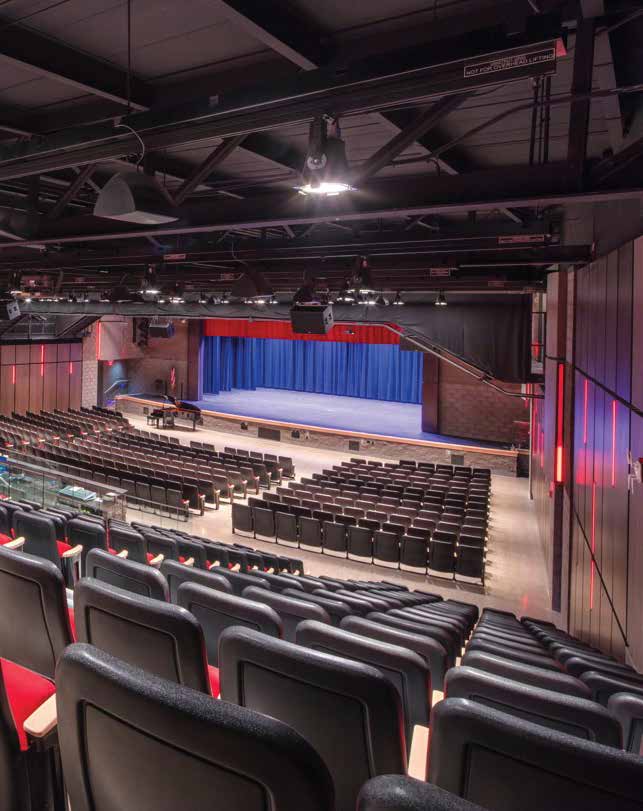
We had a venue that was probably the most difficult ever because it was professional players. It’s a college that was building a recital hall where we had 12 feet of ceiling height, period. Rectangular room, extremely long, extremely low. And these were classically-trained, professional musicians who were picky, picky, picky. We took them to a venue we had AFC installed to let them hear it. They were skeptical it could make their room work, but we told them they were just going to have to throw away their brain when we get this thing running and just enjoy the room. I think we got 64 loudspeakers in this particular room—we were able to take this 12-foot height room and make it sound like it’s got a 24-foot ceiling with all of the detail and energy. These classical players were absolutely thrilled with it. Then, secondarily, the electronic music department, through Dante, is able to access each of those speakers for electronic music performances with surround sound spatial mixing. So they’re doing some crazy stuff with their system. That was probably the most challenging one because it wasn’t pleasing the audience, which is easier. It was pleasing the players on stage who were very critical and very skeptical of the idea of electronics as opposed to physics. But we explained with 12 feet of ceiling height, that’s all we got and we can’t make this sound like a recital hall the way you want it to be unless we do this. Now they are a huge proponent—the guy that runs that facility has said great things about it to all kinds of people, which has really opened up some doors with closed minds who don’t like electronics. Let’s put it that way.
What has AVL Designs got planned coming up next?
We’ve got a lot of projects. We’ve got a school where we’re doing a large performing arts center that’s being built from the ground up, and three large rehearsal rooms and orchestra and choral, and we’re putting AFC in all of them. We’re going to be able to take the acoustic condition of the stage and transfer it into the rehearsal rooms so they will literally be able to rehearse as if they were on the stage in their individual practice spaces. If the choral group is in front of the stage on risers, that condition can be programmed back into the choral rehearsal space. It’s going to be kind of like an AFC system on steroids. It’s just going to be racks of these things. We had initially redone their high school auditorium a few years back. It was kind of a retrofit fix, but the room was dead. It sounded horrible. We put in what I would call a base-design AFC, which was just enough within their budget to really improve the room. They were thrilled. So now that they’re doing their whole new music wing and their whole new performing arts center they wanted it done properly for all the spaces. It’s going to be kind of exciting to actually get a music department where any room you’re rehearsing in can sound just like the stage.
Immersive Communication
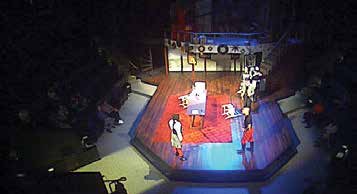
Immersive is often taken to mean spectacular. But there is another way to define it. How immersed are your users in the communication at hand? Whether that’s a play, a worship service, a class, a date, or a choir performance, how connected is the communication?
One of the most critical components of immersive communication is acoustics. It is so important that we don’t even experience it as a thing. We project the acoustics onto the experience itself. We evaluate the performer, the room, the evening, the content, our companion(s), even ourselves, based in large part on acoustics—whether we can hear comfortably or richly, whether we’re fatigued by delay or unintelligibility, or whether we feel uplifted by the flow and nuance of the communication, by a kind of “rightness” that happens when the acoustics are right for the situation.
Right for the situation is really a critical distinction, especially for a room that hosts a variety of interactions that resonate (pardon the pun) in quite different acoustical profiles. There are ways to mechanically vary a room so it suits different communications. But increasingly there are electronic options. Variable acoustics technology has been around for decades, but it has become increasingly accessible. From a business and budget standpoint, users are gradually understanding its role in the success (and revenue) of a multi-purpose venue. When you can make the room really work for a wider range of events and customers, your guest performers and your audiences will come back. Because they will be happier with the communication that happens in that room.
Immersion is also a two-way street—it affects those on stage as well. The communication of performers, pastors, and educators is materially shaped by how they experience the acoustics of the room—does it reinforce them or isolate them? Does the audience feel comfortable and reflect back that comfort and engagement? It’s important to help your customers evaluate that value equation to know whether an investment in variable acoustics may be worth it—they may even decide to trade something else, especially in a ground-up rebuild where the acoustics are at most a fraction of the investment. If it’s a multi-purpose venue, it’s worth a conversation.
“We’re starting to get installs all over the country and at different types of venues and budgets,” reports Joe Rimstidt, Systems Design Engineer at Yamaha Professional Audio’s, Commercial Installations division and an expert on the company’s Active Field Control (AFC). “It’s so valuable to multi-purpose venues and it’s within reach.
“Electronic systems have matured in the last couple of decades,” he continues. “They’re faster to set up and easier to tune and keep stable.” The systems are individually designed for each venue and can be regenerative (omni-directional speakers) or in-line (close-miked, processed sources) or a hybrid. They can mange early reflections, lift voices, and of course provide a range of reverb times at the push of a button, to allow a room to seemingly change in shape and size. Variable acoustics systems can fill a hole, smooth a curve, and most dramatically provide seconds more in reverb time—if it’s a 1 second room, it can become a 2.5-3 second room and anything in between (depending on presets). The systems also allow for a range FIR files with different tonalities, depending on the frequencies you want to emphasize.
“You still need to make sure there aren’t any big acoustic problems in the room,” Rimstidt says, “the biggest being noise floor. So things like air handling on the roof, we see that a lot in high schools. Fortunately some of the consultants involved are on top of that.” Other sources of background distraction are air vents, projector lights with fans. Flutter echoes can’t be fixed. “Think of it this way,” Rimstidt says “the system can add things in but we can’t take things away.
Variable acoustics systems can also give users much more flexibility in configuring the spatial relationship between audience and performer, providing choices beyond the traditional proscenium without sacrificing communication.
“For example at the Chapman Theater (pictured) it’s a black box with seating on all three sides. Performers are always facing away from someone. But we can keep it intelligible for everyone regardless,” Rimstidt explains.
Variable acoustics systems are also being used to make a rehearsal room sound like the stage. “We will see performers and especially soloists gain so much confidence when they’ve been able to rehearse in the acoustic profile they will be performing in,” Rimstidt explains. These systems can also improve audience response for the performer so they don’t feel isolated on a dead, distant stage. Performers need a sense of room too.
As more people use variable acoustics systems, they also become more creative with those applications. “Initially we’ll ask if they have targets—they might say, ‘I want a long response with some low frequency emphasis’. Give us a target and we can hit that kind of contour.” But it goes beyond that—maybe the liveness changes for different parts of a performance, maybe the band sounds better in the choir preset.
“It’s still a subjective thing in the end, and people are understanding that it’s another creative element.” That can mean mixing the acoustics of the room, even throughout the evening. At the extreme end, the AFC speakers have even been recruited for the content mix; at one music college, with Dante running to each of the AFC speakers, they are mixed like PAs, enabling wild soundscapes and new creative options.
“Acoustics affect how you participate in an event,” Rimstidt sums up, and he’s reminded of churches as a growing market, able to better support their contemporary and traditional services in the same room.
“All of these venues are about communication. They’re about whether people feel drawn in and present in the room,” he says. “Lighting has matured tremendously over the last 3-4 decades, video the same—these improve the communication. Yet audio is the most important part of communication and the harder one to ‘see’ “. But I think people are becoming more aware of the role acoustics plays in shaping communication and experience.” –Cynthia Wisehart


